Male fur seals at Taiaroa Head
We spent two days exploring the Otago Peninsula, outside the city of Dunedin on New Zealand's South Island. On the second day there we visited a small cove called Pilot's Beach, a small crescent of sand bordered by a jumble of rocks on each side. The cove is situated on the sheltered side of Taiaroa Head, the wildlife reserve at the tip of the peninsula.
We saw Blue Penguin burrows near the beach, but not the penguins themselves since we were there during the bright midday hours. The penguins only come ashore at dusk to spend the night in their nests, returning to the sea again at first light.
We did get to see several good-sized male New Zealand Fur Seals (Arctocephalus forsteri). While we had seen some female fur seals sunning themselves at Kaikoura the week before, this was the first time we had seen the larger males of the species.
Several of these guys were swimming rather close to shore. We sat on the rocks beside the beach for quite awhile so we could watch them. We were surprised to see them lazily swimming on their backs at times, sort of lolling about, paddling just a bit with their front flippers, while their back flippers poked up above the water's surface. Unfortunately they did this too far offshore to photograph clearly, since I didn't have a telephoto lens.
Then one seal seemed to notice us, and swam toward the rocks where we sat, as if he had decided to have a look at us.
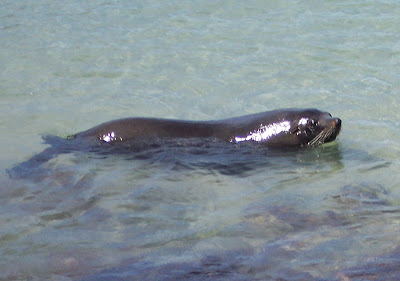
He made one pass, and then swam seaward for a bit before circling back to inspect us again. We didn't move (except to raise the camera). This time the seal came even closer, paused right in front of us, and raised his head out of the water for a better look at the strange jeans-clad mammals sitting on the rocks.

He stayed there for a few minutes, just staring at us. We stared back! He came in just a bit closer, and we began to wonder if he was going to haul out right onto the rocks where we were sitting.
 But no -- in the end, he just rolled over onto his back and swam away from shore. We were sorry to see him go back out to sea, but we were grateful to have had such a great close encounter with this very photogenic marine mammal.
But no -- in the end, he just rolled over onto his back and swam away from shore. We were sorry to see him go back out to sea, but we were grateful to have had such a great close encounter with this very photogenic marine mammal.
Not too far away, there is a fur seal breeding colony populated by females and a few dominant males. Those older males are very territorial and do not appreciate interlopers. They will challenge and fight younger males who intrude at the colony.
We were told that the fur seals we saw in the Pilot's Beach area are mostly younger males who come to the area to rest in the sheltered cove, away from the threat of the older males.
We saw Blue Penguin burrows near the beach, but not the penguins themselves since we were there during the bright midday hours. The penguins only come ashore at dusk to spend the night in their nests, returning to the sea again at first light.
We did get to see several good-sized male New Zealand Fur Seals (Arctocephalus forsteri). While we had seen some female fur seals sunning themselves at Kaikoura the week before, this was the first time we had seen the larger males of the species.
Several of these guys were swimming rather close to shore. We sat on the rocks beside the beach for quite awhile so we could watch them. We were surprised to see them lazily swimming on their backs at times, sort of lolling about, paddling just a bit with their front flippers, while their back flippers poked up above the water's surface. Unfortunately they did this too far offshore to photograph clearly, since I didn't have a telephoto lens.
Then one seal seemed to notice us, and swam toward the rocks where we sat, as if he had decided to have a look at us.

He made one pass, and then swam seaward for a bit before circling back to inspect us again. We didn't move (except to raise the camera). This time the seal came even closer, paused right in front of us, and raised his head out of the water for a better look at the strange jeans-clad mammals sitting on the rocks.

He stayed there for a few minutes, just staring at us. We stared back! He came in just a bit closer, and we began to wonder if he was going to haul out right onto the rocks where we were sitting.
 But no -- in the end, he just rolled over onto his back and swam away from shore. We were sorry to see him go back out to sea, but we were grateful to have had such a great close encounter with this very photogenic marine mammal.
But no -- in the end, he just rolled over onto his back and swam away from shore. We were sorry to see him go back out to sea, but we were grateful to have had such a great close encounter with this very photogenic marine mammal.Not too far away, there is a fur seal breeding colony populated by females and a few dominant males. Those older males are very territorial and do not appreciate interlopers. They will challenge and fight younger males who intrude at the colony.
We were told that the fur seals we saw in the Pilot's Beach area are mostly younger males who come to the area to rest in the sheltered cove, away from the threat of the older males.
Taiaroa Head on the Otago Peninsula
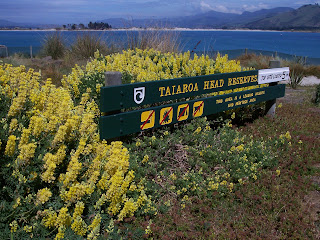 One of the nicest stretches of coastal scenery we've come across while traveling on New Zealand's South Island has been the Otago Peninsula, outside the city of Dunedin. In turn, probably the most interesting part of the Otago Peninsula (at least for us) is Taiaroa Head, situated at the mouth of Otago Harbour (see map).
One of the nicest stretches of coastal scenery we've come across while traveling on New Zealand's South Island has been the Otago Peninsula, outside the city of Dunedin. In turn, probably the most interesting part of the Otago Peninsula (at least for us) is Taiaroa Head, situated at the mouth of Otago Harbour (see map).Taiaroa Head is quite scenic. (That's it looking like a picture postcard in the second photo, taken just a few days ago.) But in addition to being pretty, it also serves as a wildlife preserve. Fur seals and sea lions frequent the waters around the headland, and haul out on the rocks and nearby beaches. There are breeding colonies of several kinds of seabirds.
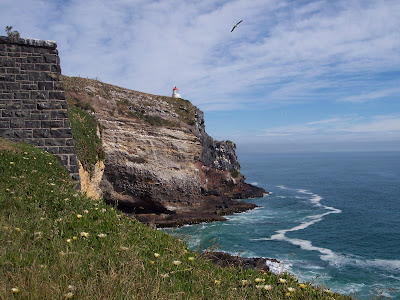 One species of seabird that lives at Taiaroa Head is the Royal Albatross (Diomedea sanfordi), an endangered species. These magnificent birds are huge, with a 10 foot (3 meter) wingspan. You can see one soaring above the lighthouse in the photo at right.
One species of seabird that lives at Taiaroa Head is the Royal Albatross (Diomedea sanfordi), an endangered species. These magnificent birds are huge, with a 10 foot (3 meter) wingspan. You can see one soaring above the lighthouse in the photo at right.The albatrosses spend up to 85% of their lives at sea, feeding on fish and squid, and sleeping on the water, but they must come ashore to nest and breed. The colony at Taiaroa Head currently is home to a Royal Albatross breeding population of about 140 birds.
 Two species of gulls also nest in this area. In fact, if you click on the second photo to enlarge it, you will see what look like myriad white spots along the face of the cliff. Those white spots are gulls -- hundreds and hundreds of gulls. They dominate this particular cliff face.
Two species of gulls also nest in this area. In fact, if you click on the second photo to enlarge it, you will see what look like myriad white spots along the face of the cliff. Those white spots are gulls -- hundreds and hundreds of gulls. They dominate this particular cliff face. And if you click on the third photo to enlarge it, you will see why that cliff face, and the top of the wall where the gulls are standing, look white!
Next time we'll show you some of the other wild residents of Taiaroa Head -- on land and in the water.
Labels:
marine life,
New Zealand,
Pacific,
seabirds,
surface intervals
Sunbathing at Kaikoura
On the eastern coast of New Zealand's South Island, about halfway between the cities of Blenheim to the North, and Christchurch to the south, sits the little town of Kaikoura. If you're hungry for seafood, Kaikoura is a good place to stop. There are several fresh seafood markets there, and many of the restaurants specialize in "Crayfish," the clawless rock lobster found in the waters offshore.
 There's another attraction at Kaikoura. Just outside the town at the headland of a small peninsula that juts into the Pacific ocean there is a place where you can see wild New Zealand Fur Seals (Arctocephalus forsteri). The seals haul out onto the rocks there to bask in the sun and rest.
There's another attraction at Kaikoura. Just outside the town at the headland of a small peninsula that juts into the Pacific ocean there is a place where you can see wild New Zealand Fur Seals (Arctocephalus forsteri). The seals haul out onto the rocks there to bask in the sun and rest.
The day we visited Kaikoura we saw about a half dozen seals in the area called Point Kean. The seal pictured here was sunbathing not far from the parking area, making it relatively easy to take some photos while still maintaining a safe distance between us and her. (We think this is a female, based on size. Adult female fur seals, we are told, usually weigh between 30 and 40 kg).
These seals are a protected species. Hunting them has been banned since 1946. According to information provided by New Zealand's Department of Conservation, the current population of these animals is about 100,000 but it is estimated that there would have been around one million seals before hunting began in the mid-1700s.
Currently there are breeding colonies of fur seals at several locations on New Zealand's coast.
 There's another attraction at Kaikoura. Just outside the town at the headland of a small peninsula that juts into the Pacific ocean there is a place where you can see wild New Zealand Fur Seals (Arctocephalus forsteri). The seals haul out onto the rocks there to bask in the sun and rest.
There's another attraction at Kaikoura. Just outside the town at the headland of a small peninsula that juts into the Pacific ocean there is a place where you can see wild New Zealand Fur Seals (Arctocephalus forsteri). The seals haul out onto the rocks there to bask in the sun and rest.The day we visited Kaikoura we saw about a half dozen seals in the area called Point Kean. The seal pictured here was sunbathing not far from the parking area, making it relatively easy to take some photos while still maintaining a safe distance between us and her. (We think this is a female, based on size. Adult female fur seals, we are told, usually weigh between 30 and 40 kg).
These seals are a protected species. Hunting them has been banned since 1946. According to information provided by New Zealand's Department of Conservation, the current population of these animals is about 100,000 but it is estimated that there would have been around one million seals before hunting began in the mid-1700s.
Currently there are breeding colonies of fur seals at several locations on New Zealand's coast.
New Zealand's Little Blue Penguins
 When we think of marine life, we most often think of fish, of course. Next we probably think of invertebrates such as crabs and lobsters, corals, and marine mammals like dolphins and whales. We sometimes overlook the fact that there are many species of birds that qualify as marine life, too.
When we think of marine life, we most often think of fish, of course. Next we probably think of invertebrates such as crabs and lobsters, corals, and marine mammals like dolphins and whales. We sometimes overlook the fact that there are many species of birds that qualify as marine life, too.One kind of marine bird that we are getting to know during our New Zealand trip is the penguin. Until we came to New Zealand, we had never seen a live penguin except at a zoo or marine park. This trip has afforded us our first opportunity to see penguins in the wild.
Several species of penguin make their home on the coasts of New Zealand's South Island, but by some stroke of fate or luck, the first one we are learning about -- and writing about in The Right Blue -- is the Blue Penguin (Eudyptula minor).
 The feathers on the Blue Penguin's back and head really are blue, but they look more blackish when they are wet. They are cute little fellows -- and they are indeed little. In fact the Blues are the smallest penguin species in the world. Adults usually weigh about a kilogram (a little more than two pounds), and they stand about 30 cm (1 foot) tall.
The feathers on the Blue Penguin's back and head really are blue, but they look more blackish when they are wet. They are cute little fellows -- and they are indeed little. In fact the Blues are the smallest penguin species in the world. Adults usually weigh about a kilogram (a little more than two pounds), and they stand about 30 cm (1 foot) tall.Despite their small size, Blue Penguins can swim fast underwater -- about 8 km (5 miles) per hour. They spend most of the daylight hours swimming at sea, diving again and again to catch their prey -- small fish and squid. According to the folks at the Oamaru Blue Penguin Colony, these birds are known to make an average of about 800 dives each day. Each dive lasts about 20-30 seconds, although Blue Penguins are able to hold their breath for up to two minutes.
When they swim on the surface, they assume a prone position that makes them look like chubby ducks. On land they stand upright, and walk in a waddle, rocking back and forth with each step.
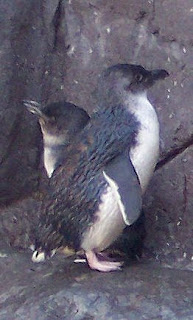 Penguins' wings are used to propel them when they swim underwater. When they walk on land, they tend to hold out their wings to help balance. They are not able to fly.
Penguins' wings are used to propel them when they swim underwater. When they walk on land, they tend to hold out their wings to help balance. They are not able to fly.Their natural predators at sea are sharks, killer whales, sea lions, and leopard seals. On land they are sometimes killed by ferrets, dogs, and other predatory mammals. Like other marine animals, Blue Penguins also face man-made dangers. They sometimes become entangled in fishing gear and other marine debris, and their nesting grounds are damaged and encroached upon by people and pets.
Approximately 200 Blue Penguins make their home in an area near the port of Oamaru -- situated on the South Island's east coast, about an hour's drive north of the city of Dunedin. Volunteers have provided the Oamaru Blue Penguin colony with nesting boxes in artificial burrows (see photo below). Access to the area is restricted during the hours when most of the birds come ashore to rest and feed their chicks.
They come ashore each evening at dusk, and spend the night on land in burrows where they nest. At dawn they emerge from their burrows and return to the sea to find their food, often ranging as much as 25 km (about 15 miles) offshore in the course of a day's swim.
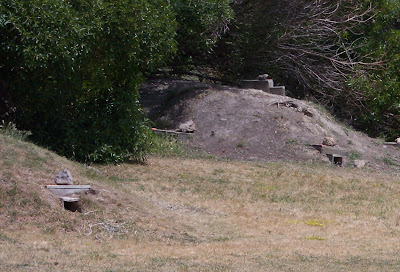 To see more detail, click on any of the photos to enlarge.
To see more detail, click on any of the photos to enlarge.
South Island Safari
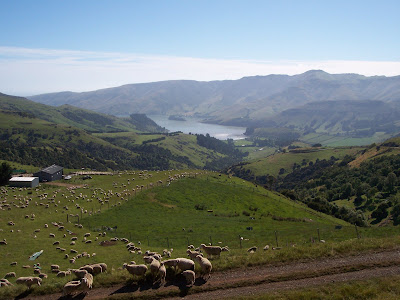 Last week we told our readers that we would be suspending our diving tales for the remainder of 2007 because we were going to be traveling for the month of December. Then we posted a photo from Australia, but that was a tease. Our stopover in Sydney actually was quite brief.
Last week we told our readers that we would be suspending our diving tales for the remainder of 2007 because we were going to be traveling for the month of December. Then we posted a photo from Australia, but that was a tease. Our stopover in Sydney actually was quite brief.The photo here (click on it to enlarge) should give a clue to our true destination. What country is known for rugged coastlines, magnificent scenery -- and sheep? (Lots and lots of sheep!)
In case you haven't guessed, we are in New Zealand. More specifically, we are on the South Island where we will remain for the rest of the month. Here's a link to a decent map of New Zealand's South Island.
We arrived in New Zealand several days ago, having flown from Sydney directly to Christchurch. We decided to base ourselves in Christchurch for the first few days in order to adjust and get our bearings -- and, since this is a driving trip, to get more practice driving on the left side of the road before we venture further afield!
As a rule, we are not so fond of cities and we are more inclined to spend our time in the countryside when we travel. We also seem to have a built-in water sensor that reliably draws us to the nearest seacoast, lake shore or river bank wherever we go. For this trip, our intention is to see most of the coast of the South Island, as well as some of the mountains and lakes.
A major focus of this journey is to see creatures that we have never seen before -- and may never see again, at least in their natural habitat. It is one thing to see such animals in zoos and marine parks, but another entirely to see them in the wild. We are hoping to see fur seals, several species of penguins, Royal albatross, and other marine birds indigenous to New Zealand. We're calling this our South Island safari.
Over the next several weeks, we will be posting photos and stories about New Zealand's South Island whenever we find ourselves with a good internet connection, so stay tuned. This is the beginning of the tale.
Today's photo is of a sheep farm near Port Levy on the Banks Peninsula, not far from Christchurch. Lucky sheep to have a view like that!
Labels:
New Zealand,
surface intervals
Surface Interval
 Divers refer to the periods between dives as 'surface intervals.' When multiple dives are performed in a relatively short space of time, the length of the surface interval figures importantly into the calculations involved in planning the depth and duration of successive dives in order to avoid decompression sickness.
Divers refer to the periods between dives as 'surface intervals.' When multiple dives are performed in a relatively short space of time, the length of the surface interval figures importantly into the calculations involved in planning the depth and duration of successive dives in order to avoid decompression sickness.In addition to that technical use of the term, divers often use the term 'surface interval' amongst themselves as a waggish reference to any period when they are not diving: Home life, school or work? To the hard-core diver, they're all mere surface intervals!
We're having one of those kinds of surface intervals right now.
We are traveling and will be away from home for the remainder of this month. That means we are away from our photo archive and our old dive logs from which we mine most of our stories.
We will continue to post stories in The Right Blue while we are traveling, but they will be different from our usual fare. Instead of writing about adventures past, we thought it might be fun to see what we can find to share with our readers in real time as we travel about.
Although this trip is not a dive trip, we will be near the sea most of the time. We intend to maintain our usual theme, but it will be mostly from a surface vantage point. So, please indulge us while we get ourselves out of the water for awhile, and come along with us to a part of the world we've wanted to visit for a long, long time.
Subscribe to:
Comments (Atom)

BNSullivan.jpg)
BNSullivan.jpg)
BNSullivan.jpg)


BNSullivan.jpg)
BNSullivan.jpg)
BNSullivan.jpg)

BNSullivan465x300.jpg)
BNSullivan.jpg)
BNSullivan930x600.jpg)

